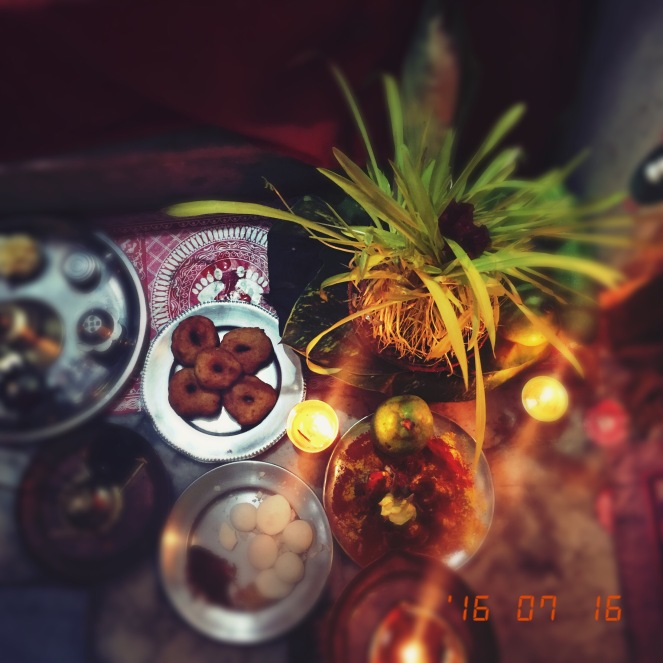“Tomorrow is a holiday because of harela . What in the world is harela?”
“Harela ? Actually it’s a Kumaoni festival during which cereal grains are sprouted at home. After a few days when they begin resembling long grass ,they are cut and distributed among the family members in a ritual, praying for their good health, prosperity and happiness.”
Ok ! That made little sense. It was definitely not an explanation I was proud of but that happened to be the sum total of my knowledge. Time to roll up my sleeves and learn more about my cultural heritage.
Morning dawned and I had a purpose. I had bathed, was alert , armed with my phone and a check of mental questions, made my way to the puja room . Its entrance gleamed under the light of the fluorescent tube in the passage,the intricate red and white aipan patterns on the floor taking a life of their own .

Peeping in, I spied the ‘long grass’ growing in a pot surrounded by seasonal fruits , the oil lamps scattered , the idols benevolently overseeing the offerings .

“Where are the badas ?”
Oh no ! Of course, no function, be it birthday, wedding , festival , puja is ever complete without the deep fried bada being offered to the gods. So it was back to the kitchen. An hour later , the badas or the desi donuts,made of urad dal, were ready. It was time .

In the puja room , jostling in the crowd was a plate with the idols of Lord Shiva, Goddess Parvati , Lord Ganesh and a kinsman, covered in red and yellow powder.
“These are called ‘digrae’ and are made of mud, fashioned right here on the dining table. This also happens to be the beginning of saavan , the month dedicated to Lord Shiva who married Goddess Parvati. According to the lore, their wedding is solemnised on 15th July, hence the auspicious colour.”

“It is not all religious for there is an agrarian connection too. Harela is celebrated once a year. It begins early on 6th July, when seeds of different cereals are planted in small pots to coincide with the sowing of the Kharif crop in the hills. It is kept in the puja room and tended carefully for ten days.”

Today is the eleventh day when the brilliant green is cut. With a snip , the stalks (harela) are placed on a plate , along with the prasad and tikka and then dispensed among the family members with a quaint Kumaoni blessing, calling for rejuvenation and prosperity.
The harela dispensing can wait for now.There is more to the story .

“You know, during this time, in the hills, the fleet of workers labouring in the fields are fed for as long as the sowing lasts . It could be two or three days and a fantastic vegetarian feast is prepared especially for them. Special treats include tobacco for all and there is a person whose sole job is to drum a rhythm and sing for them as entertainment. Can you imagine what a sight it must be ?”

In that moment, the longing in the voice,replete with memories of the rolling hills and fields, cut across the generations,for one who had lived through it and the other through the tales. Urban living does comes at a price – trees lopped to make space for luxury apartments, the view of the distant mountain tops completely blocked by the concrete monster.

I was not aware of the significance of harela .Very enlightening.
LikeLiked by 1 person
Now you know what I have been up to the whole day . Thrilled that not only you read but you commented too 🙂
LikeLike
Informative, and glad to know that at least we have some festivals which have fixed dates. Pictures are sheer poetry, discovered another of your talents.
LikeLiked by 1 person
I learnt so much too along the way . As for the photos , it’s Apple but you are a fan too ,so you know what I mean . Thanks Manjari!
LikeLike
Had a vague idea about the significance of harela after reading your post I have become more learned.
LikeLiked by 1 person
Thank you for reading and commenting. I look forward to your feedback on other posts as well.
LikeLike
That’s an informative piece intertwined with appealing and visually appeasing that seem to juxtapose with the festive mood . Our nation being so diverse, yet so similar in traditions despite the difference in times and distances.
LikeLiked by 1 person
I absolutely agree
LikeLike
Facts were really enlightening ! Good research .congrats!
LikeLike
There are so many rituals that we follow blindly and it is heartening to know that there is a reason behind it all. Harela set me on this track and now I appreciate it more than ever . Thank you for stopping by and commenting. Cheers!
LikeLike
A glimpse of Kumaon 🙂
Beautifully written and the pictures perfectly describe the importance ‘harela’ holds in every family .
Good going .
LikeLiked by 1 person
Happy you liked the post .Sadly over the period of time or maybe it’s the urban living , many of our meaningful customs and traditions are now reduced to mere rituals (I’m guilty of that ) . This was an effort to connect to my roots and was pleasantly surprised too. Thanks for the morale boosting comment.
LikeLiked by 1 person
Wonderfully written! I am sure all our cultural events have a scientific logic and an environmental significance. You have authenticated it with your efforts and research.
LikeLiked by 1 person
I agree Rajeev. There are reasons behind our traditions. The task now is to uncover, spread the word and hold on to them. Also a fantastic way to remember where we come from, right ?
LikeLiked by 1 person